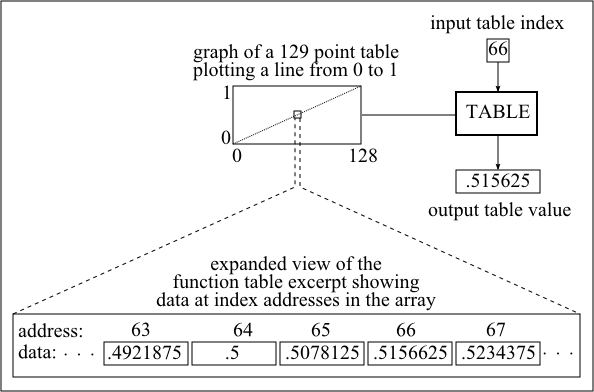 | ||
Table-lookup synthesis (or Wavetable-lookup synthesis) (Roads 1996) is a class of sound synthesis methods using the waveform tables by table-lookup, called "table-lookup oscillator" technique. The length of waveforms or samples may be varied by each sound synthesis method, from a single-cycle up to several minutes.
Contents
Terminologies
The term "waveform table" (or "wave shape table" as equivalent) is often abbreviated to "wavetable", and its derive term "wavetable oscillator" seems to be almost same as "table-lookup oscillator" mentioned above, although the word "wave" (or "waveform", "wave shape") may possibly imply a nuance of single-cycle waveform.
However, a derive term "wavetable synthesis" seems slightly confusing. In a natural usage of words, its original meaning is basically same as "table-lookup synthesis", and possibly several actions on waveform(s) may be expected, as seen on a paper about Karplus–Strong string synthesis (a simplest class of "wavetable-modification algorithm" known as digital waveguide synthesis). Then in the late-1970s, Michael McNabb and Wolfgang Palm independently develop the multiple-wavetable extension on the table-lookup synthesis which was typically used on PPG Wave and known with wavetable sweeping, and it was later referred as "multiple wavetable synthesis" by Horner, Beauchamp & Haken 1993. Simultaneously since late-1970s, also the sample-based synthesis using relatively long samples instead of single-cycle waveforms, have become influential by the introductions of the Fairlight CMI and E-mu Emulator.
Background
On the above four terminologies for the classes of sound synthesis methods, i.e.,
- Wavetable synthesis — original, generic meaning (i.e. a single-cycle table-lookup synthesis).
- Multiple wavetable synthesis — developed by McNabb and Palm, typically used on PPG Waves.
- Wavetable-modification algorithm — including digital waveguide synthesis.
- Sample-based synthesis
if these had been appropriately used to distinguish each other, any confusions could be avoided, but it seems failed historically. At latest in the 1990s, several influential sample-based synthesis products were marketed under the trade names similar to "wavetable synthesis" (including Gravis Ultrasound wavetable card, Creative Wave Blaster wavetable daughterboard, and Microsoft GS Wavetable SW Synth), and these confusions have further affected on the several industry standards (including MPEG-4 Structured Audio algorithmic and wavetable synthesis, and AC97 optional hw acceleration wavetable synth). As a rebound of these, at the latest since the mid-2000s, a new confusion seem to begin flourish. Merely a subclass of generic wavetable synthesis, i.e. McNabb and Palm's multiple wavetable synthesis, tends to be erroneously referred as if it was a generic class of whole wavetable synthesis family, exclusively.
As a background of these confusions, the difficulties of maintaining the consistencies between concepts and terminologies during the rapid developments of technology, may be significant. And it is a reason why this slightly classical terminology "Table-lookup synthesis" is explained on here.
